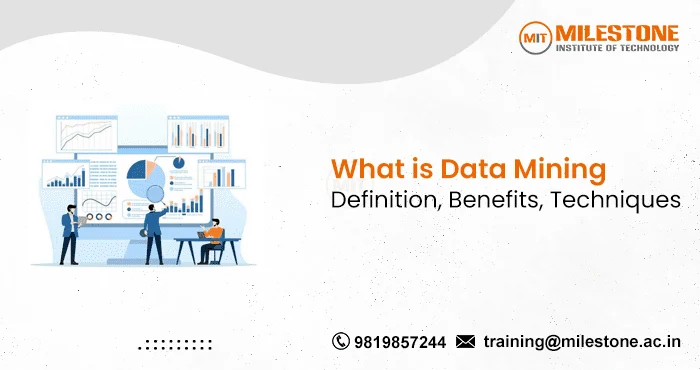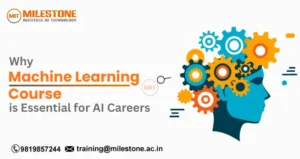In today’s data-driven world, the capacity to obtain meaningful insights from massive volumes of data is critical. Businesses, researchers, and analysts rely on sophisticated tools and approaches to make sense of large datasets. Data mining is one of the most effective and popular approaches in this field. This blog dives into the concepts of
what is data mining, its importance in
data science, the processes involved, its different applications, and the methodologies used.
What is Data Mining? – Definition
Data mining is the method of anomaly, correlation, and pattern discovery inside big databases intended for use in prediction. Raw data is turned into useful information by this process using a range of statistical, mathematical, and computer approaches. Several steps—data collecting, preparation, analysis, and interpretation—are part of this process, which ultimately generates practical insights.
Why is Data Mining Important in Data Science?
For many different reasons, data mining is absolutely essential in the field of
data science.
- Enhanced Decision Making: It offers insights based on facts instead of intuition which enables companies to make wise decisions.
- Predictive Analytics: It makes predictive analytics possible, which lets companies forecast future trends and actions, thereby staying ahead of the competition.
- Efficiency Improvement: It helps to simplify processes and increase output by bringing out opportunities for development and inefficiency.
- Customer Insights: It helps to improve customer service as well as personalized marketing plans by means of a deeper knowledge of consumer preferences and behavior.
- Risk Management: It methods help companies to find potential risks and fraud, which allows them to act before problems arise.
What is Process of Data Mining? How does it work?
Basically, the process of data mining consists in the following stages:
- Data Collection: Collecting information from several sources—including external sources, databases, and data warehouses.
- Data Preparation: Data cleansing and transformation to guarantee consistency and correctness. Handling missing values, eliminating duplicates, and data standardizing all come under this stage.
- Data Exploration: Conducting the research to understand the structure and features of the data. This might involve spotting important factors and visualizing statistics.
- Model Building: Creating prediction models by use of statistical and machine learning techniques applied to the ready data. Common approaches consist of association, classification, grouping, and regression.
- Evaluation: Evaluating the model by means of several criteria including accuracy, precision, recall, and F1 score. This last stage guarantees the dependability and efficiency of the model.
- Deployment: Using the model in a practical setting to produce forecasts and analysis. This might entail tracking the model’s performance and combining it with commercial applications.
- Interpretation and Action: Understanding the outcomes and turning them into sensible plans and choices.
What are the uses of Data Mining?
Mining of large insights has extensive applications in many different sectors:
- Marketing: Identifying consumer categories, predicting behavior, and enhancing marketing tactics.
- Finance: Identifying fraud, evaluating reliability, and predicting stock market movements.
- Healthcare: Analyzing patient information helps to enhance healthcare results, treatment strategies, and diagnosis accuracy.
- Retail: Improving consumer experience, spotting purchasing patterns, and streamlining inventory control.
- Telecommunications: Reducing turnover rates, enhancing network dependability, and customizing services.
- Manufacturing: Improving the manufacturing process optimization, equipment failure prediction, and quality control.
Types of Data Mining Techniques
Analysis and interpretation employ various techniques from mining:
- Classification: Organizing information into pre-defined groups or classifications. Common techniques comprise neural networks, support vector machines, and decision trees.
- Clustering: Grouping related data elements according to their characteristics Popular clustering algorithms are DBSCAN, hierarchical clustering, and k-means.
- Regression: Forecasting a continuous variable depending on the connections among the variables. Popular techniques are ridge regression, poisson and linear regression.
- Association Rule Learning: Identifying connections between several variables in large databases. Common use of this method is in market basket analysis.
- Anomaly Detection: identifying anomalies or odd trends in data. Network security and fraud detection both frequently benefit from this method.
- Sequential Pattern Mining: Finding trends and patterns in sequential data—that is, consumer transactions or time-series data.
Learn Data Mining
Data Mining is an essential technique carried out in
data science and data analytics. If you want to learn crucial skills in data science, we will recommend Milestone Institute of Technology. They have an experienced faculty for providing quality training, personal guidance, and many more things for students’ successful career journeys. As per the research and students review MIT is known as the best institute for Engineering, IT, Graphic Designing, Industrial Automation courses. Start your successful Career journey with the best training centers and institutes.
Frequently Asked Questions
What is the difference between data mining and machine learning?
Typically utilizing statistical techniques, mining aims to find trends and information from massive databases. On the other hand, machine learning is creating algorithms that let computers predict and learn from data. Although mining is a more general process, one of its main methods is machine learning.
Can data mining be used for real-time analysis?
Yes, real-time data analysis can benefit from it. According to developments in technology and the availability of strong tools, data can be mined and analyzed in real-time, which allows companies to make quick and wise decisions.
How is data mining different from data analysis?
Data analysis is the study of data to summarize its properties and develop conclusions; data mining is the search for patterns and extraction of insights from vast databases using several techniques. It can be considered as a subset of data analysis with a focus toward pattern detection.
How can I start learning data mining?
Starting your data mining education might include joining up for online or offline courses, going to seminars, or pursuing a degree in data science or a closely related discipline. Gaining mastery in data mining methods also depends much on practical experience via projects, internships and practical training.




